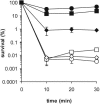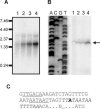Deletion of the sigB gene in Bacillus cereus ATCC 14579 leads to hydrogen peroxide hyperresistance
- PMID: 16204573
- PMCID: PMC1265915
- DOI: 10.1128/AEM.71.10.6427-6430.2005
Deletion of the sigB gene in Bacillus cereus ATCC 14579 leads to hydrogen peroxide hyperresistance
Abstract
The sigB gene of Bacillus cereus ATCC 14579 encodes the alternative sigma factor sigma(B). Deletion of sigB in B. cereus leads to hyperresistance to hydrogen peroxide. The expression of katA, which encodes one of the catalases of B. cereus, is upregulated in the sigB deletion mutant, and this may contribute to the hydrogen peroxide-resistant phenotype.
Figures




Similar articles
-
Deletion of sigB in Bacillus cereus affects spore properties.FEMS Microbiol Lett. 2005 Nov 1;252(1):169-73. doi: 10.1016/j.femsle.2005.08.042. Epub 2005 Sep 9. FEMS Microbiol Lett. 2005. PMID: 16171954
-
Identification of the sigmaB regulon of Bacillus cereus and conservation of sigmaB-regulated genes in low-GC-content gram-positive bacteria.J Bacteriol. 2007 Jun;189(12):4384-90. doi: 10.1128/JB.00313-07. Epub 2007 Apr 6. J Bacteriol. 2007. PMID: 17416654 Free PMC article.
-
YlaC is an extracytoplasmic function (ECF) sigma factor contributing to hydrogen peroxide resistance in Bacillus subtilis.J Microbiol. 2006 Apr;44(2):206-16. J Microbiol. 2006. PMID: 16728958
-
What sets Bacillus anthracis apart from other Bacillus species?Annu Rev Microbiol. 2009;63:451-76. doi: 10.1146/annurev.micro.091208.073255. Annu Rev Microbiol. 2009. PMID: 19514852 Review.
-
Regulation of bacterial oxidative stress genes.Annu Rev Genet. 1991;25:315-37. doi: 10.1146/annurev.ge.25.120191.001531. Annu Rev Genet. 1991. PMID: 1667460 Review. No abstract available.
Cited by
-
Home Alone: Elimination of All but One Alternative Sigma Factor in Listeria monocytogenes Allows Prediction of New Roles for σB.Front Microbiol. 2017 Oct 11;8:1910. doi: 10.3389/fmicb.2017.01910. eCollection 2017. Front Microbiol. 2017. PMID: 29075236 Free PMC article.
-
Short- and long-term biomarkers for bacterial robustness: a framework for quantifying correlations between cellular indicators and adaptive behavior.PLoS One. 2010 Oct 29;5(10):e13746. doi: 10.1371/journal.pone.0013746. PLoS One. 2010. PMID: 21060783 Free PMC article.
-
Catalase activity as a biomarker for mild-stress-induced robustness in Bacillus weihenstephanensis.Appl Environ Microbiol. 2013 Jan;79(1):57-62. doi: 10.1128/AEM.02282-12. Epub 2012 Oct 12. Appl Environ Microbiol. 2013. PMID: 23064331 Free PMC article.
-
Loss of SigB in Listeria monocytogenes Strains EGD-e and 10403S Confers Hyperresistance to Hydrogen Peroxide in Stationary Phase under Aerobic Conditions.Appl Environ Microbiol. 2016 Jul 15;82(15):4584-4591. doi: 10.1128/AEM.00709-16. Print 2016 Aug 1. Appl Environ Microbiol. 2016. PMID: 27208116 Free PMC article.
-
Heuchera Creme Brulee and Mahogany Medicinal Value under Water Stress and Oligosaccharide (COS) Treatment.Evid Based Complement Alternat Med. 2019 Feb 17;2019:4242359. doi: 10.1155/2019/4242359. eCollection 2019. Evid Based Complement Alternat Med. 2019. PMID: 30906414 Free PMC article.
References
-
- Baillie, A., and J. R. Norris. 1963. Studies of enzyme changes during sporulation in Bacillus cereus, using starch gel electrophoresis. J. Appl. Bacteriol. 26:102-106.
-
- Beers, R. F., and I. W. Sizer. 1952. A spectrophotometric method for measuring the breakdown of hydrogen peroxide by catalase. J. Biol. Chem. 195:133-140. - PubMed
-
- Bsat, N., A. Herbig, L. Casillas-Martinez, P. Setlow, and J. D. Helmann. 1998. Bacillus subtilis contains multiple Fur homologues: identification of the iron uptake (Fur) and peroxide regulon (PerR) repressors. Mol. Microbiol. 29:189-198. - PubMed
MeSH terms
Substances
LinkOut - more resources
Full Text Sources
Medical
Molecular Biology Databases

